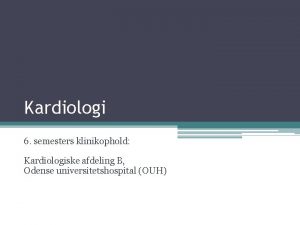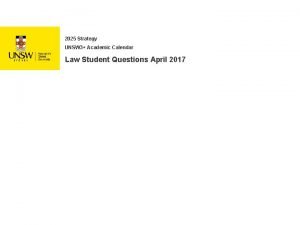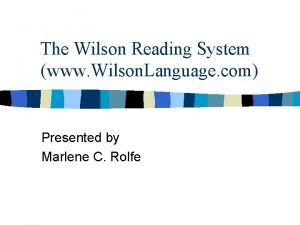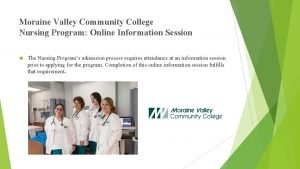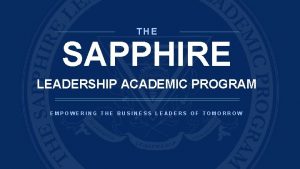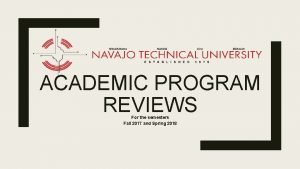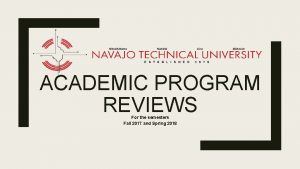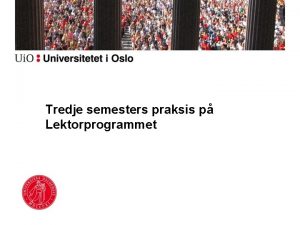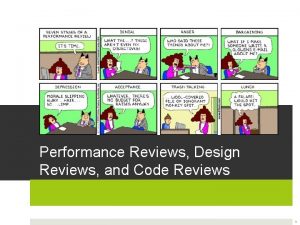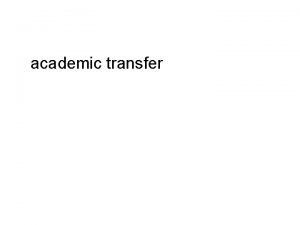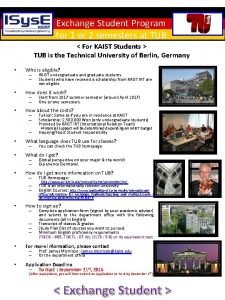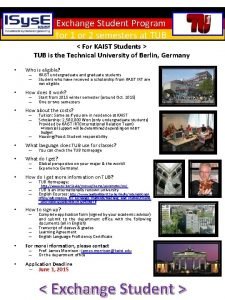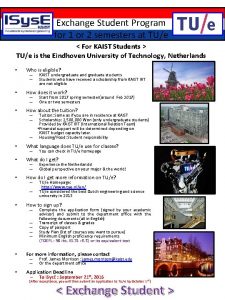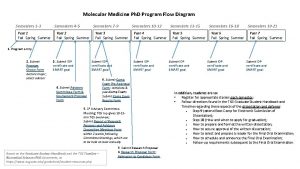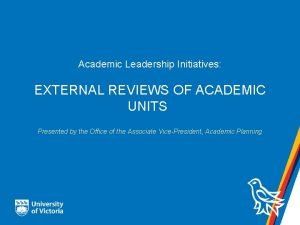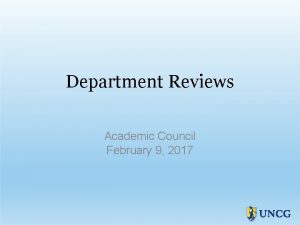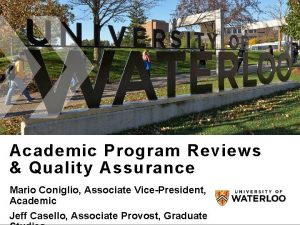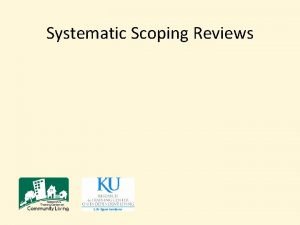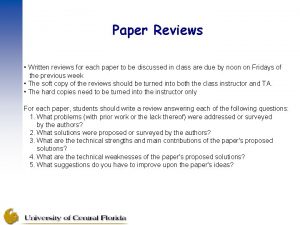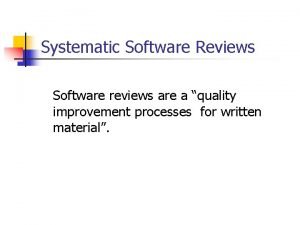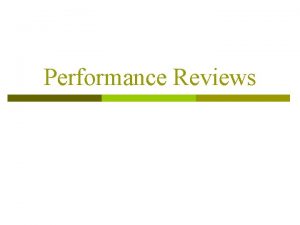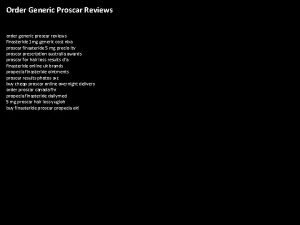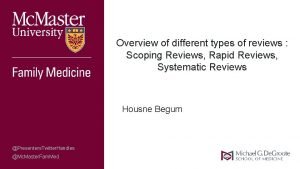ACADEMIC PROGRAM REVIEWS For the semesters Fall 2017






















- Slides: 22

ACADEMIC PROGRAM REVIEWS For the semesters Fall 2017 and Spring 2018

Members Committee on Instructional Effectiveness (CIE): 2017 -18 § Dean Jerlynn Henry, Dean of Student Services - Co-Chairperson § Dr. Casmir Agbaraji, Dean of Undergraduate Studies - Co. Chairperson § Geraldine Gamble, Chief Financial Officer - Member § Coleen Arviso, Director of E-Learning – Member § Dr. Peter Moore, Associate Professor – Member § Daniel Vandever, Communication Director – Member § Arlena Benallie, Director of Chinle & Teec Nos Pos Member § Dr. Tim Begaye, Dean of Research and Discovery – Member § Dr. Wesley Thomas, Dean of Graduate Studies – Member

Members Program Review Committee: § Dr. Agbaraji, Dean of Undergraduate Studies § Harry Whiting, Professor § Sheena Begay Director of Assessment § Jerlynn Henry, Dean of Student Service § Lemanuel Loley, Job Placement Coordinator § Dr. Perphelia Fowler, HR Director § Geraldine Gamble, CFO § Coleen Arviso, E-Learning Director

Purposes As part of Navajo Technical University’s (NTU’s) commitment to the planning and evaluation cycle of planning and evaluation, we use a rigorous program review process. Each program at NTU is reviewed once every three (3) years by the Program Review Committee to determine if a program is viable or if any changes need to be made.

Goal Program review is a critical component to NTU’s commitment to continuous improvement and to aligning its mission and strategic plan with its curricular programs. Program review follows the adoption of the three-year Strategic Plan and provides each school with the opportunity to reflect on its programs; review its internal methods for assessment and program improvement; review trends in enrollment, graduation, and resources; and outline plans for the upcoming years.

Reasons for Program Review NTU implements program review for these reasons: – – to determine if a program is viable. – – – – – to evaluate the quality of a program in relation to relevant national standards. to ensure that a program’s mission, goals, and priorities align with NTU’s mission and strategic and academic plans. to assist the University and departments in achieving optimal use of available resources. to help with faculty and staffing requirements to help analyze whether physical space is appropriate for teaching needs to determine if laboratory equipment is adequate to determine if supplies allocated to the programs to facilitate teaching are adequate for enrollment management, and for employment, graduation, persistence, and retention data for revenue and budget information to help plan programs in relation to future trends in the industry

Program Review Advisors: (Advisors include a Subject Matter Expert/Advisory Board Member, CIE Member 2, & Faculty Member (All Reviewers will change depending on Program in Review). Each school will submit the program review packet during the program review cycle. This packet will be reviewed by the Program Review Advisors using the Program Review template and rubrics. This will result in a recommendation containing the findings. These resulting findings will be provided to the University Cabinet and to the CIE committee to assist them in strategic decision making and resource allocation. These results will also be made available to the University community. Each Program will submit a Program Review every Three Years The University Cabinet will determine a plan for each Program Review submitted and notify the Program Coordinator, Chair, & Dean of any recommendations. The CIE will discuss results and share the reports with the University Cabinet. This will be used in Strategic Planning & Resource allocation. Program Review Committee & Program Coordinator will assemble the packets. Program Review Advisors will write up the results and recommendations.

Program Review Cycle

Program Reviews Completed with Recommendations Not Completed with Recommendations ■ Industrial Maintenance and Operations ■ Electrical Trades ■ Information Technology (Not a completed packet) ■ Mathematics ■ New Media ■ Industrial Engineering ■ Public Administration Each Cabinet member will get a copy of the Program Review.

RESULTS & RECOMMENDATIONS Academic Year 2017 -18

Electrical Trades Findings & Recommendations Strengths ■ § This is a good program. § The program is aligned with the University's mission, and has a good mission statement and good goals that fit their program well. § § ■ The Electrical Trades program is accredited by a national organization for educational ■ standards (the National Center for Construction Education and Research). ■ The program is engaged in course/program assessment and has changed the program to be a better educational opportunity for its ■ students. § The Electrical Trades program has turned in a comprehensive portfolio. § Eight students received their electrical certificate at the end of the Fall 2017 semester, and six students will be receiving their electrical certification in the spring 2017. We don't have accurate numbers on completion rates or on students acquiring jobs after program completion. It's hard to lay this at the feet of the Professors/Instructors of Electrical Trades since some of these numbers must be provided by the Data Office and these are hard numbers to generate. The number of students appears to be dwindling. We suggest that a vigorous campaign to recruit students be initiated. Faculty share a small office space with two cubicles. (135 sq. ft. ) They need a space for student or visitors (for confidentiality reasons). Another challenge: the advisor did not advise the students properly according to the program schedule or program of study. The students are not graduating on time and conflicting with graduating on time. Our recommendation: someone needs to sit down with the advisors and Mr. Griego’s schedule to eliminate scheduling conflicts. Refer to the Electrical Trades Program Review packet for more information.

Information Technology Strengths ■ A new Professor was hired. Findings & Recommendations ■ Obtaining faculty advisor information on the IT program has been problematic. Basically, the main contact of the IT program has not been providing necessary information that can be used to complete the program review. Dr. Stomp and Dr. Darwich have identified Mr. Mark Trebian as the main contact for the IT program. We note that Dr. Stomp and Dr. Darwich did provide as much information as they could offer. ■ The program review committee recommends a new main IT program advisor/coordinator to be identified by the CIE committee. ■ Program Review not complete. ■ One of the major findings the data demonstrates is the enrollment in the IT programs is decreasing. The students are not completing the IT programs. The enrollment numbers are very low. ■ Information Technology (IT) and Computer Science (CS) are two totally different areas of study. They need to be separated and CS should have its own program. ■ The IT program has potential and ■ a lot of opportunity such as ■ adding certifications. ■ Overall effectiveness is difficult to ■ determine when the program does not provide pertinent ■ information. The IT program should devise a program mission statement that reflects the department’s “purpose, ” by defining why a program exists and should also make sure that their program aligns with the mission statement of the university. Learning goals for the major are not clearly measureable and we recommend that the program revisit their learning goals and align them with viable measures that are identifiable with levels of “knowledge, ” “understanding, ” “appreciation, ” “skills, ” and “competence. ” We have a huge concern that no program assessments or course assessments were included in the program review. The absence of IT program assessments leads to an alarming question to the programs’ integrity and student learning. How does the IT program ensure and communicate its findings, processes, and improvement efforts? The IT program has a huge disconnect between their goals and their assessment. The Program Review Team recommends deletion of the ‘Applied Computer Technology’ certificate because of the low enrollment, outdated curriculum, and low support in this program. If deleting this program is approved, the students need to be made aware of the change immediately by informing them about a teach-out plan to help them stay on task as required by Higher Learning Commission - Number: FDCR. B. 10. 010. ■ We strongly recommend an Advisory Board. Establishing an IT Program Advisory Board institutes best practices by getting potential employers to share their desirable IT skill-sets they need while also sharing their real-world experiences and knowledge. ■ Another concern is how much is this program costing the university? What funding source supports this program? What resources are needed to continue this program? A financial review of the program needs to be performed. ■ A final point, the Program Review Team would like a better understanding as to where graduates gain employment? Are the students obtaining jobs? Are employers satisfied with NTU IT students? Refer to the IT Program Review packet for more information.

Mathematics Strengths Findings & Recommendations ■ The program does however lack the enrollment and enough documentation of assessment. The program made real improvements, but there is no evidence of the reason for the changes. It just explains faculty are actively involved in assessment but does not have clear evidence of what some of these assessments were. Many of the students in the program are not choosing math as their first major but as a double major with the bachelor degree programs in engineering. All the math courses taken in the mathematics certificate and associate programs are embedded in the engineering programs. ■ Great faculty who actively participate in committee work and who actively improve their program. ■ The Mathematics department has a mission to provide all students strong foundations of mathematics that will help them succeed. ■ The Mathematics Department continues to modify the curriculum. ■ The math program streamlined introductory and intermediate algebra into a single class. ■ The faculty and staff in the mathematics program actively participate in course and general education assessments. The outcomes of the assessment are used to guide changes in the succeeding semester. ■ The number of students taking higher level mathematics (College ■ Algebra and higher) is increasing. ■ Engineering students who have completed required mathematics courses are encouraged to have dual majors (Engineering and ■ Mathematics). ■ Advisement is focused on pre-requisites and course substitutes as needed to complete a mathematics degree. ■ The program is in high need on the Navajo reservation, which lacks math teachers. Therefore both the marketing team and members of the mathematics department need to actively recruit new students. Refer to the Mathematics Program Review packet for more information. ■ The program needs more marketing and recruitment. If there are more students through recruitment, there will be more students in the Bachelor of Science degree in mathematics education. What is the cost to run this program? How is this program funded.

New Media Strengths ■ The mission of the New Media B. A. S. IT Program is aligned with the University mission. ■ Program recognition - AIHEC Film Festival Awards: Best Animation, Best Film, Best Cinematography, Best Documentary Tribal College Journal Film Competition: Best Film 2017, 2018. Gallup Route 66 -Hour Film Contest: People’s Choice. ■ Student Learning Outcomes are reviewed and revised as needed, every Fall and Spring semester, including updates, upgrades and/or changes in textbooks, learning outcomes, objectives and measurement. These changes are based on student interviews, surveys, and course assessment recommendations. ■ New Media students are advised by the New Media Advisor. Refer to the New Media Program Review packet for more information. Findings & Recommendations ■ The New Media program was developed in 2011, but because of limited resources related to personnel and space, it has been slow in building traction. ■ The program’s enrollment has remained consistent over the past few years, but more growth needs to be achieved considering how much money has been invested. ■ Graduation rates have been shockingly low since the program was developed, which is something that needs considerable attention. ■ An advisory board needs to be established in order to increase program relevance and to monitor completion, retention and persistence rates. ■ More faculty would also help. ■ Current staff could help serve as adjunct faculty and the radio station could be used to help foster student learning. ■ Students have complained that courses are not offered in a timely manner that would allow them to graduate quickly. ■ To be successful, the program must have more funding for equipment and more professors as dedicated as Hondo.

Public Administration Findings & Recommendations Strengths ■ Curricular changes were made in March, 2016 and approved by the Curriculum Committee in April, 2016. The new graduation checklist has been incorporated and published in the NTU General Catalog for 2016 -2018. ■ Based on the result of the Program Assessment review there is a need to change the goals of the Public Administration program, make it specific and measurable. ■ What is the cost to run this program? How is this program funded? This program needs promoting and advertising to increase the enrollment especially when this program has good enrollment. ■ Enrollment is decreasing and student survey indicate there are no evening and weekend courses that are being offered. This is a program that is needed but has been neglected. The professors are available, but lacking the recruitment for new students. ■ Financial data was not received for review. In addition, program reviews should be conducted by faculty with full knowledge and background of the program. ■ Need information on where students are obtaining employment. ■ Faculty in the program are obtaining higher degrees. ■ A College of Business Club (COBC) was created and chartered in Fall of 2016. The club’s objectives are to promote all business programs, disseminate program information, retain business students, encourage and promote activities that enhance the business student’s self-esteem and culture identity. ■ The Public Administration program enriches NTU’s strategic plan by committing to academic excellence by providing leadership and educational support based on the Dine Philosophy of Education. Refer to the Public Administration Program Review packet for more

Industrial Engineering Strengths Findings & Recommendations ■ Students have been taking classes on a casual ‘when I want, what I want’ basis. Currently faculty are trying to get students lined up into cohorts by having them take the lowest level courses on their checklists that they have not taken. § The Industrial Engineering Program mission is well aligned to the university’s mission and strategic plan. § The program provides value to the Diné community through research, community engagement, service learning, and activities designed to ■ The program mostly uses Tech 322 and Tech 325 for foster cultural and environmental preservation and sustainable economic classes. These two spaces are extremely closely development. This includes success in gaining relevant and fulfilling scheduled. For example in the present semester there employment and the readiness to pursue graduate education. would only have been space for one more class in the § The curriculum has just been updated for Industrial Engineering, Monday through Thursday time frame. There a total of Electrical Engineering, Engineering Technology and Pre-Engineering to twenty four classes scheduled through the week. better align the order in which courses are taken so that there is less ■ These same rooms contain eight cubicles in use for conflict about when courses should be offered. offices. § ABET Accreditation, anticipated in the summer of 2018, will help in the growth of the program. We have had students who decided to transfer to ■ What is the cost to run this program? How is this program other schools because we were not accredited. Accreditation will make funded? us one of only two schools in New Mexico with an Industrial Engineering program. ■ This program needs promoting and advertising to § The program anticipates being able to do outreach with local industry, increase the enrollment especially when NTU is ABET approved. some of whom have been deliberately sitting on the sidelines until our accreditation was completed. § The program offered grants for IE and EE scholarships and for a summer ■ Datasets should not be conflicting and most current figures should be reported. camp. They offered a summer camp this summer for Many Farms High School students, which combines dual instruction and social activities for ■ There is no program budget. Program evaluators need to the students. see if the program is underfunded, or what the net Refer to the Industrial Engineering Program Review packet for more § The program has great faculty and collaboration. expenses are per student. Adjusting these values may information.

Overview of Strengths ■ A majority of faculty collaborated, communicated, and coordinated. ■ The program shows pedagogical innovation. ■ The program audited the program and course curriculum and deliveries. ■ Adding new marketable program recommendations ■ Future vision for programs. ■ Instructional changes. ■ Curriculum or program changes. ■ Operational funding request. ■ Documented program reviews.

Overview of Challenges ■ Follow-up on ensuring Programs are current and need to ensure student learning at all times. ■ Program Reviews need to be a solid force in decision making when program budgets are determined. ■ Obtaining Data – Program Budget, Revenue Generated, Program Cost, and main program Funding Source. ■ Time consuming and failure to meet deadlines/delays ■ Unrealistic expectations for additional resources ■ Understanding that the findings and recommendations are advisory, and non-binding ■ Academic Advising needs to be evaluated and look at best practices, student need and program of study needs to be followed for students to stay on track. ■ Establish be recruitment plan to focus on programs. ■ Establish a network of surrounding employers by programs.

Additional Information ■ The program review process is described on the NTU Policies + Docs at url http: //www. navajotech. edu/faculty-staff/policies-docs. ■ Higher Learning Commission (HLC) – Policy Title : Criteria for Accreditation Number: CRRT. B. 10. 010 - ■ Criterion 4. Teaching and Learning: Evaluation and Improvement. The institution demonstrates responsibility for the quality of its educational programs, learning environments, and support services, and it evaluates their effectiveness for student learning through processes designed to promote continuous improvement. – ■ Core Components ■ 4. A. The institution demonstrates responsibility for the quality of its educational programs. ■ 1. The institution maintains a practice of regular program reviews. Criterion 5. Resources, Planning, and Institutional Effectiveness. The institution’s resources, structures, and processes are sufficient to fulfill its mission, improve the quality of its educational offerings, and respond to future challenges and opportunities. The institution plans for the future.

Next Steps… § The Program Review Committee met and discussed the administrative task for program reviews. As part of NTU’s academic improvements and the need for transparency, the committee believes that the process for program reviews as specified in the new Assessment Planning & Reporting Guide be brought under the guidance of the Student Learning Consultant. § As is the case with most universities, the practice for academic program review, is better maintained and documented under the responsibility of Academic Planning. Therefore, moving forward for the academic year Fall 2018 - Spring 2019, the Program Reviews will be assigned to Mr. Mc. Laughlin, Student Learning Consultant. § The completion of the current program reviews for academic year Fall 2017 - Spring 2018 that process will be completed by the current team, hence this presentation. Memo

Upcoming Program Reviews Fall 2018 Spring 2019 ■ Advanced Manufacturing Technology (B. A. S. ) ■ Diné Culture Language and Leadership (B. A. and M. A. ) ■ Carpentry (Certificate) ■ Energy Systems (A. A. S. ) ■ Chemical Engineering (A. A. S. ) ■ Commercial Driver License (Technical Cert. ) ■ Computer-Aided Drafting (Certificate) ■ Construction Technology (Certificate and A. A. S) ■ Business Administration (Pending HLC Approval) ■ Environmental Science & Nat Res (Certificate, A. A. S. , and B. S. ) ■ General Education ■ Law Advocate (A. A. S. ) ■ Legal Assistant (Certificate) ■ Pre-Nursing (Certificate)

Questions? Ask Dr. Casmir Agbaraji, Dean of Undergraduate Studies
 Perikardiet
Perikardiet Unsw term dates 2022
Unsw term dates 2022 Njdv
Njdv Wilson language system
Wilson language system Moraine valley teas test
Moraine valley teas test Lonestar kingwood nursing
Lonestar kingwood nursing Penn state sapphire
Penn state sapphire Ptc academic
Ptc academic Iso 22301 utbildning
Iso 22301 utbildning Novell typiska drag
Novell typiska drag Tack för att ni lyssnade bild
Tack för att ni lyssnade bild Returpilarna
Returpilarna Shingelfrisyren
Shingelfrisyren En lathund för arbete med kontinuitetshantering
En lathund för arbete med kontinuitetshantering Underlag för särskild löneskatt på pensionskostnader
Underlag för särskild löneskatt på pensionskostnader Personlig tidbok fylla i
Personlig tidbok fylla i Anatomi organ reproduksi
Anatomi organ reproduksi Vad är densitet
Vad är densitet Datorkunskap för nybörjare
Datorkunskap för nybörjare Tack för att ni lyssnade bild
Tack för att ni lyssnade bild Debatt artikel mall
Debatt artikel mall Magnetsjukhus
Magnetsjukhus Nyckelkompetenser för livslångt lärande
Nyckelkompetenser för livslångt lärande
